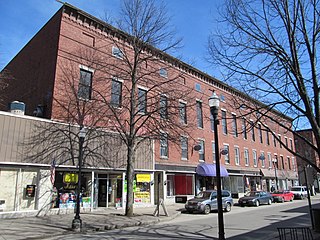
The College Block/Lisbon Block is an historic commercial and civic building in Lewiston, Maine, United States. Built in 1855-56, it is the oldest surviving building in the city of the Franklin Company, the city's major early developer. The building has house many local civic groups, and served as Lewiston's town hall prior to its incorporation as a city in 1863. It was listed on the National Register of Historic Places in 1986.

The Olmsted-Hixon-Albion Block is a historic commercial block at 1645-1659 Main Street in the South End of downtown Springfield, Massachusetts. The building is actually three separate 19th-century buildings that were conjoined by internal connections in 1929, making a good example of adaptive reuse of commercial architecture in the city. The building was listed on the National Register of Historic Places in 1983.

The Musgrove Block is a historic commercial building at 2 Main Street in the center of Andover, Massachusetts. The three story brick building was built in 1895 on the site of a former town green, and forms part of Andover's central Elm Square intersection. The building exhibits Romanesque Revival styling, featuring granite trim elements and ornate brick detailing. It was listed on the National Register of Historic Places in 1982.

63 Nassau Street is a landmark building located on Nassau Street between Fulton and John Streets in the Financial District of Manhattan, New York City. It was built in the Italianate style c.1844, and had its cast-iron facade, attributed to James Bogardus, added in 1857-59, making it one of the first cast-iron buildings in the city. The attribution to Bogardus, a pioneer in the architectural use of cast iron, comes because of medallions of Benjamin Franklin identical to those on four other Bogardus projects, all now demolished. George Washington was also once represented with medallions.

Flanley's Block is a historic commercial building at 349–353 Main Street in Wakefield, Massachusetts, US. Built about 1895, it is a well-preserved local example of late 19th-century Italianate commercial architecture. The building was listed on the National Register of Historic Places in 1989.

The Chesterton Commercial Historic District is a historic district in Chesterton, Indiana.

The Carl Albert Federal Building is a historic courthouse located in McAlester, Oklahoma. Built in 1914, the facility was renamed in 1985 in honor of former Speaker of the House Carl Albert, a native of the town. It previously served the United States District Court for the Eastern District of Oklahoma. It was listed on the National Register of Historic Places in 2000.

The Bank Street Historic District is a group of four attached brick commercial buildings in different architectural styles on that street in Waterbury, Connecticut, United States. They were built over a 20-year period around the end of the 19th century, when Waterbury was a prosperous, growing industrial center. In 1983 they were recognized as a historic district and listed on the National Register of Historic Places.

The Wheeler Opera House is located at the corner of East Hyman Avenue and South Mill Street in Aspen, Colorado, United States. It is a stone building erected during the 1890s, from a design by Willoughby J. Edbrooke that blends elements of the Romanesque Revival and Italianate architectural styles. In 1972 it became the first property in the city to be listed on the National Register of Historic Places, and the second in Pitkin County. The upstairs auditorium hosts a number of events every year, ranging from nationally prominent music and comedy acts and some of the Aspen Music Festival's events to productions by local community groups.

The Collins Block is a historic commercial building located at 204 South Mill Street in Aspen, Colorado. It is a brick and stone structure erected in the early 1890s.
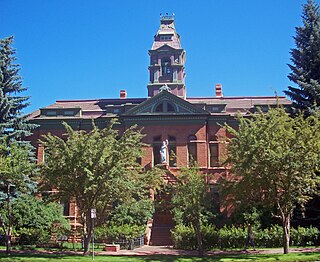
The Pitkin County Courthouse is located on East Main Street in Aspen, Colorado, United States. It is a large brick building erected in the late 19th century that serves as offices not just of Pitkin County's courts but its other governmental agencies, and the Aspen police. A landmark of the city, it was listed on the National Register of Historic Places in 1975.

The Red Onion is a restaurant located on East Cooper Avenue in Aspen, Colorado, United States. It is the oldest restaurant in the city, housed in a three-story red brick Italianate building dating to the late 19th century. In 1987 it was listed on the National Register of Historic Places as "New Brick–The Brick Saloon", along with other historic properties in the city.

The former Riede's City Bakery building is located on East Hyman Street in Aspen, Colorado, United States. It is a small wooden commercial building erected in the 1880s. In 1987, it was listed on the National Register of Historic Places.

Pioneer Park, also known as the Henry Webber House or the Webber–Paepcke House, is located on West Bleeker Street in Aspen, Colorado, United States. It is a brick structure erected in the 1880s, one of the few such homes in the city. In 1987 it was listed on the National Register of Historic Places.
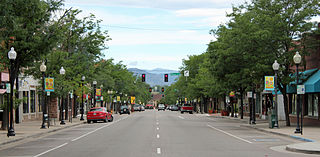
The Littleton Main Street is a historic district located along W. Main Street, from South Curtice Street, to South Sycamore Street in Littleton, Colorado. The district dates from 1890. The nineteenth century buildings are red pressed brick, many with stone foundations and trim. These buildings replaced smaller frame structures from the pioneer era and proclaimed the success of their builders through solid construction and application of exterior ornament.

The Bowles–Cooley House is located at the corner of West Francis and North First streets in Aspen, Colorado, United States. It is a brick structure in the Queen Anne architectural style built during the 1880s. In 1987 it was listed on the National Register of Historic Places along with many other historic properties in the city.

The Hotel Jerome is located on East Main Street in Aspen, Colorado, United States. It is a brick structure built in the 1880s that is often described as one of the city's major landmarks, its "crown jewel". In 1986 it was listed on the National Register of Historic Places. It is operated by Auberge Resorts.
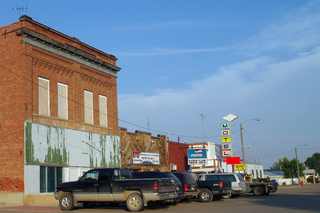
Saco Mercantile is a site on the National Register of Historic Places located in Saco, Montana. It was added to the Register on December 8, 1997. It has also been known as the Saco Co-operative Store and as the C.P. Martin Store.

The Wallace Block is a commercial building located at 101-113 South Ann Arbor Street in Saline, Michigan. It was listed on the National Register of Historic Places in 1985.
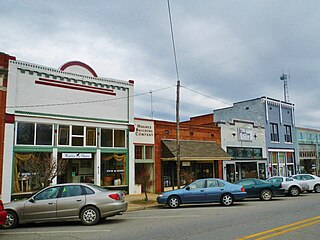
The Downtown Montevallo Historic District in Montevallo, Alabama is a historic district which was listed on the National Register of Historic Places in 2013. It included 30 contributing buildings and four non-contributing buildings.





















